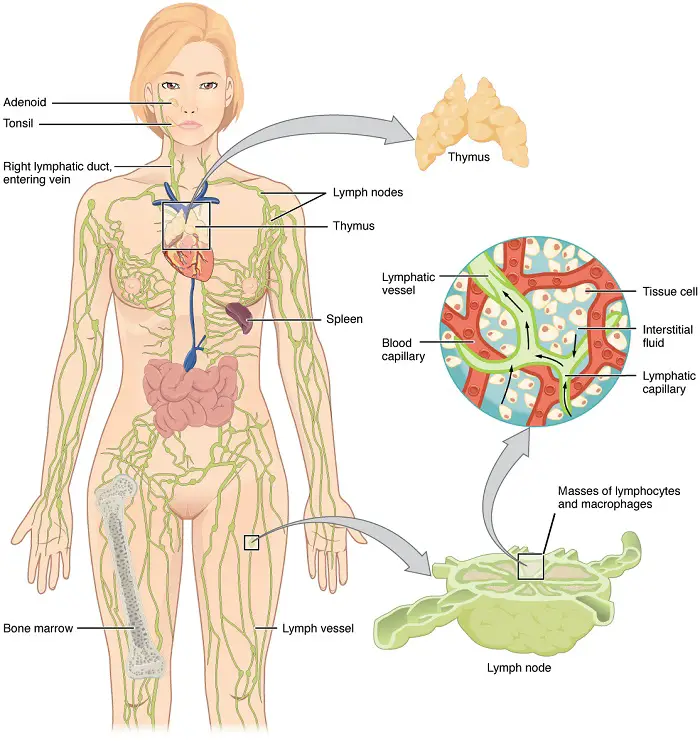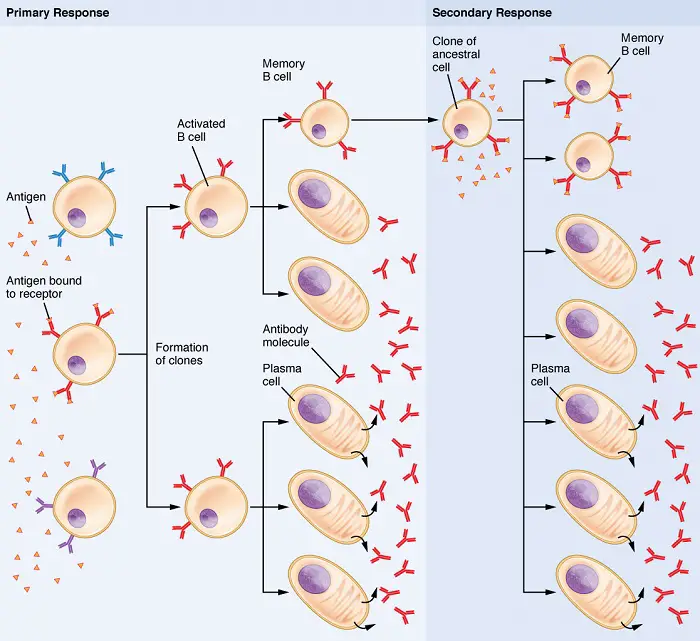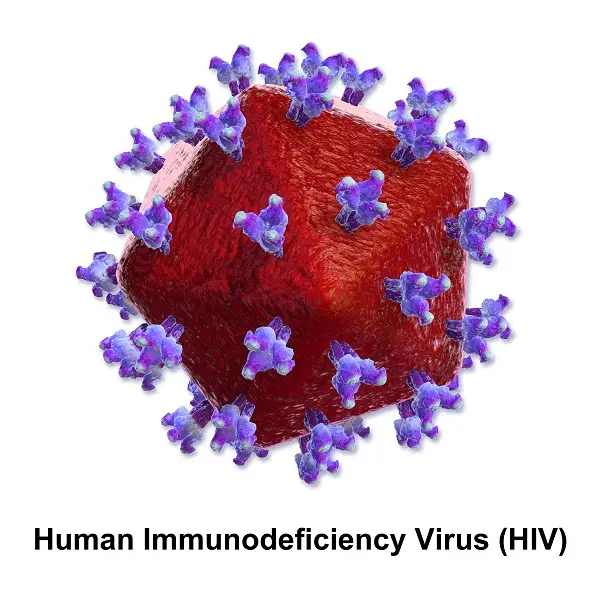Lymphatic System
As part of the immune system, the lymphatic system returns excess body fluids to the circulatory system. Let’s learn more about it in this reviewer.
What Is The Lymphatic System?

The lymphatic system is involved in both innate and adaptive immunity. It is made of a branching network of vessels, numerous lymph nodes (i.e., round organs packed with macrophages and lymphocytes), the bone marrow, and several organs. The lymphatic vessels carry a fluid known as lymph, which is similar to the interstitial fluid surrounding body cells but has less oxygen and fewer nutrients.
This system is closely associated with the circulatory system. With infectious agents winding up in the circulatory system, they are carried into the lymphatic system which can usually filter them out. The filtered fluid can then be recycled into the circulatory system. Thus, the lymphatic system has two main functions: (1) to return fluid to the circulatory system and (2) to fight infection.
Functions of the Lymphatic System
1. Circulatory Function
A small amount of fluid that enters tissues through the capillaries is not able to reenter the blood capillary. As such, this fluid is returned to the blood via lymphatic vessels.
The lymphatic vessels are highly branched and the fluid that enters the lymphatic system by diffusion into lymphatic capillaries are intermingled among blood capillaries.
Lymph drains from lymphatic capillaries into larger and larger lymphatic vessels and eventually re-enters the circulatory system through two lymphatic vessels that fuse with veins in the chest. Lymphatic vessels resemble veins in having valves that prevent backflow of fluid. Like veins, they also depend on the movement of skeletal muscles to squeeze their fluid along the vessel.
2. Immune Function
When the body fights an infection, the organs of this system become a major battleground. As lymph circulates through lymphatic organs like the lymph nodes, it carries microbes, parts of it, or toxins picked up from infection sites anywhere in the body. Inside lymphatic organs, macrophages residing there permanently may engulf invaders as part of the innate immune response.
Lymph nodes fill with huge numbers of defensive cells, causing tender “swollen glands” in the neck and armpits where doctors may look for as a sign of infection. Many of the defensive cells in the lymph nodes are lymphocytes, which are responsible for the adaptive immune response.
Lymphocytes
Lymphocytes come from stem cells in the bone marrow. Immature lymphocytes continue developing in the marrow to become specialized as B lymphocytes or B cells while other immature lymphocytes migrate to the thymus, a gland above the heart, becoming specialized as T lymphocytes or T cells. In turn, lymphocytes can have two defensive actions against infections in body fluids and cells.
Differences Between a B and T Cell
When a B or T cell develops, the cells differentiate from other cells by synthesizing many copies of a specific protein which are then incorporated into the plasma membrane. These protein molecules stick out from the cell’s surface and act as antigen receptors, capable of binding to specific types of antigens. The cell’s antigen receptors are in place before they ever encounter an antigen.
After the B cells and T cells have developed their antigen receptors, these lymphocytes leave the bone marrow and thymus and move via the bloodstream to lymph nodes, spleen, and other parts of the lymphatic system. In these organs, many B and T cells take residence and encounter infectious agents that have entered the body.
When a B or T cell within a lymphatic organ first confronts a specific antigen it was programmed to recognize, it differentiates further and becomes a fully mature component of the immune system, ready to respond.

These cells lead to two adaptive immune responses:
- The humoral immune response produced by B cells that defends primarily against bacteria and viruses present in body fluids. In this response, the B cells secrete free-floating antibodies into the blood and lymph (historically, blood and lymph were called body “humors”, hence the name). The antibodies mark invaders by binding to them and the resulting antigen-antibody complexes are easily recognized for destruction and disposal by phagocytes.
- The response produced by T-cells is the cell-mediated immune response which defends against infections inside body cells. Defensive T cells destroy body cells infected with bacteria or viruses. However, not all T cells function as defensive T cells as some function indirectly to promote phagocytosis by white blood cells or by stimulating B cells to produce antibodies. Thus, T-cells play parts in both cell-mediated and humoral responses.
A closer look at an antigen shows a small-exposed region called an epitope. This is the site where antigen receptors on B cells and antibodies recognize and bind. The specific region of an antigen receptor or antibody that recognizes an epitope is the antigen-binding site. This may be due to their complementary structures akin to how a lock requires a specific key.
Antigens usually have several different epitopes and so may activate several lymphocytes that lead to several different antibodies. These antibodies are important because of their response and how they are selected.
Clonal Selection and Primary and Secondary Responses
The humoral and cell-mediated responses defend against antigens through a process known as clonal selection. As antigens encounter a diverse pool of B and T lymphocytes, only particular antigens interact with a few lymphocytes, those that bear receptors able to recognize it.
Once activated by the antigen, the lymphocytes proliferate, forming a clone of thousand cells “selected” to recognize and respond to the antigen. Some of these cells are effector cells, which act immediately in combating infection, others known as memory cells lie in wait, ready to help activate the immune system in future exposure to the antigen. This process is a vital step in the immune response against infection.

The first time a particular antigen enters our body and selectively activates our lymphocytes is called a primary immune response. Due to few lymphocytes being activated, this initial response is slow with enough effector cells that secrete antibodies to combat the infection are produced days after. Since adaptive immunity creates a memory of a specific antigen, the memory cells produced in this response confer protection in subsequent encounters with the pathogen.
If memory cells produced in the primary response are activated by a second exposure to the same antigen, it initiates the secondary immune response. Memory cells formed in the primary response enable the rapid formation of many effector cells specific to the antigen. Because a large pool of memory cells is activated, it is faster and stronger than the primary response. Like the primary response, this also leads to both effector and memory cells.
Antibodies & T Cells: Immune Actions
Antibodies do not kill pathogens but mark them. A closer look into its molecular structure shows its function in the humoral immune response. Each antibody molecule consists of four polypeptide chains bonded together in a Y-shape. The tip of each arm of the Y forms an antigen-binding site which allows for recognition and binding function. The stem of the antibody helps mediate the disposal of the bound antigen.
All antibody mechanisms involve two parts: specific recognition and attachment phase followed by nonspecific destruction phase. After forming the antigen-antibody complex, it is able to boost the function of phagocytes of the innate immune response in two ways: neutralization, where antibodies bind to surface structures in bacteria or viruses, blocking their ability to infect host cells and making them more recognizable to macrophages; or agglutination that leads to pathogens being clumped and bound by antibodies, making them easier for phagocytes to capture.
In addition to phagocytosis, antibodies are able to promote the complement system that ultimately leads a target cell or foreign body to rupture due to proteins penetrating their cell membranes.
The antibody-producing B cells of the humoral response make up one arm of the adaptive immune response and help identify and destroy invaders in our blood, lymph, or interstitial fluid. In other words, those outside our body’s cells. But what about those invaders that enter and infiltrate our cells?
The cell-mediated immune response produced by cytotoxic T cells battles pathogens that have already entered the body cells. Another type of T cell, a helper cell, is able to trigger both humoral and cell-mediated immune responses.
Helper T cells do not carry out the responses themselves but signals from them initiate the production of antibodies that neutralize pathogens and activate cytotoxic T cells that kill infected cells. The role of helper T cells is so essential to immunity that without them, there is basically no immune response. These cells are the ones attacked by HIV (Human Immunodeficiency Virus) leading to the condition AIDS (acquired immunodeficiency syndrome).

Two requirements must be met for a helper T cell to activate our adaptive immune responses:
- A foreign molecule to bind specifically to the antigen receptor of the T cell.
- An antigen to be displayed on the surface of an antigen-presenting cell which can be macrophages or B cells.
The ability of lymphocytes to recognize the body’s own molecules enables our adaptive immune response to battle foreign invaders without harming our healthy cells. In addition to this, the immune system is able to distinguish the body’s own cells from those of other people. This is due to many genes containing information that produce major histocompatibility complex (MHC) molecules.
This sometimes goes against our favor, however, as in the case of receiving organ transplants or tissue grafts where T cells may recognize the MHC markers of the donor’s cells as foreign and attack them.
Disorders of the Immune System
Our immune system sometimes malfunctions, leading to immune disorders. Autoimmune disorders are those resulting in our immune system turning against some of our body’s own molecules. Lupus (medically systemic lupus erythematosus) is an example, characterized by skin rashes, fever, arthritis, and kidney malfunction. Another example is rheumatoid arthritis, where immune cells attack the synovium, a thin layer of tissues lining our joints.
In contrast to autoimmune disorders, immunodeficiency disorders are underreactions of the immune system, resulting in a defective or absent immune response. An example is the rare congenital disease called severe combined immunodeficiency (SCID) where both T and B cells are absent or inactive. AIDS is an acquired immunodeficiency and so is Hodgkin’s disease, cancer that damages the lymphatic system and imperils our immune system.
Allergies are exaggerated responses to otherwise harmless antigens in the environment. These antigens are called allergens. Allergic responses lead to mast cells releasing histamine and so, drugs called antihistamines are used to interfere and provide temporary relief from allergy.
Aside from dealing with foreign bodies invading the body, the organ systems must also regulate the contents of our body. In the next section, we’ll tackle the organ system that functions in maintaining water and solute concentrations.
Next topic: Urinary System
Previous topic: Immune System
Return to the main article: Animal Form and Functions (Overview)
Download Article in PDF Format
Test Yourself!
1. Practice Questions [PDF Download]
2. Answer Key [PDF Download]
Copyright Notice
All materials contained on this site are protected by the Republic of the Philippines copyright law and may not be reproduced, distributed, transmitted, displayed, published, or broadcast without the prior written permission of filipiknow.net or in the case of third party materials, the owner of that content. You may not alter or remove any trademark, copyright, or other notice from copies of the content. Be warned that we have already reported and helped terminate several websites and YouTube channels for blatantly stealing our content. If you wish to use filipiknow.net content for commercial purposes, such as for content syndication, etc., please contact us at legal(at)filipiknow(dot)net
